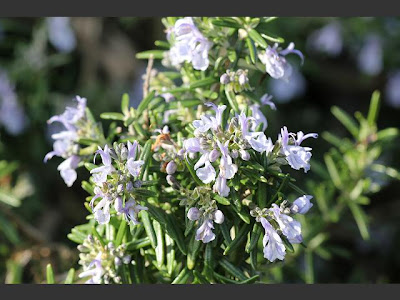
Although rosemary is a native plant of the Mediterranean and Asia, it is still reasonably hardy in cooler areas. Rosemary is a good choice if you want shrubs that are able to withstand droughts well. It will survive a severe lack of water for lengthy periods of time.
Rosemary has leaves which look like pine needles. It is these needles which can be finely chopped and used to flavour a variety of dishes, especially stuffing. Many cooks simply cut sprigs of rosemary and place many roasted meats, especially lamb, pork, chicken and turkey with great results.
You will make things far easier on yourself if you start with a nursery grown plant. Rosemary can take some time to fill in as a plant, so expect to pay more for a mature plant than for a small rosemary start.
Rosemary is usually propagated by cuttings. Seeds can be difficult to germinate and often don't grow true to their parent. It's much faster to start with a cutting and you will be sure of what type of plant you will get. It's possible to root rosemary in a glass of water, but a bit more effort will give more dependable results.Seeds are readily available from most major seed merchants, although only for Rosmarinus officinalis - we have not seen any seed for sale for the other varieties. The seeds are cheap to buy online, although propagation is erratic. Sow the seeds in potting compost around mid-May time and place in a sheltered position in the garden - unfortunately you will only achieve a success rate of about 15%. The seedlings may well take up to 2 months to appear so don't give up hope until maybe 3 months has past.

Bring the potted rosemary inside once the temperature inches into the 30s. It can be a little trickier to keep rosemary happy inside. Your rosemary plant will still require 6-8 hours of full sun, so artificial lights may be necessary. Heat is not as crucial as sunlight.
Move your potted rosemary back outdoors once all danger of frost has passed.
As with most potted plants, the soil in your rosemary pot will degenerate through watering and root growth. Repot at least once a year. Spring is a good time to repot your rosemary, but it should be fine no matter what time of year you get to it.
When the rosemary plant puts out considerable growth or looks like it just can't get enough water, it has outgrown its pot and needs to be transplanted into a larger one. If you want to maintain the size of your rosemary plant, root prune it by slicing off a couple of inches of the roots from the bottom and sides of the root ball and replanting in the same pot. Be sure to trim some of the top at the same time, to lessen the work load of the roots and the stress placed upon the trimmed plant. Then allow your repotted plant some time to regroup. It should reward you with many more seasons of snippings.
The herb Rosemary grows extremely well in large pots or other containers. The pots need to be reasonably deep because rosemary is a deep rooting herb. Fill the pot with a mixture of 20% sharp sand or grit and 80% standard potting compost. Make a hole in the compost and place one rooted cutting in the middle of the pot. Water the plant well to help it settle in and consolidate the soil around the roots.
No comments:
Post a Comment